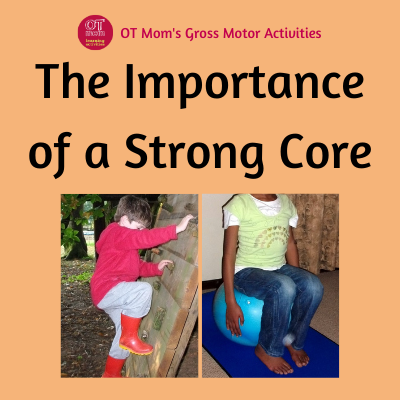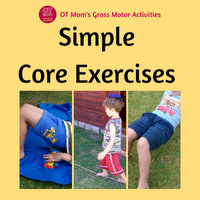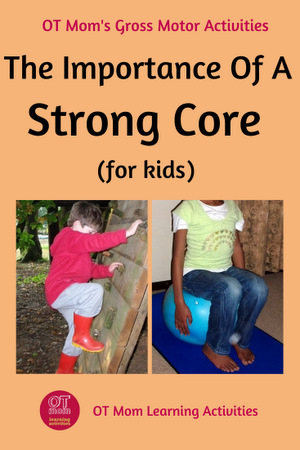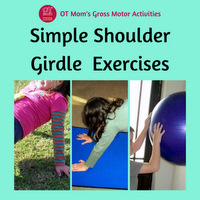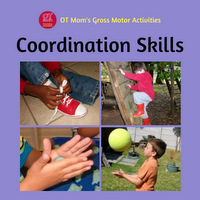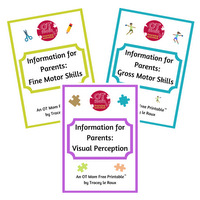- Home Page
- Gross Motor Activities
- Core Strength and Core Stability
Core Strength & Core Stability:
Why It Matters
Developing core strength and core stability should be an important part of your child's gross motor development. Strengthening the core and core stability are concepts increasingly taken into account by sports trainers and health professionals such as physiotherapists.
This article will help you understand why it is important for your child to have strong and stable core muscles.
* Haz click aquí para español: ¿Por qué es Importante Fortalecer el Core de los Niños?
I sometimes link to products (#Ad) that are similar to those I use and love. If you do purchase something through my links, I will receive a small commission that helps support my site - thank you!
What is Core Stability?
Every time we move our arms and legs, force is being applied to our spine. It has been said that if we were to remove all the muscles from around the spine, so it was simply made up of the ligaments and bones (vertebrae), it would only be able to withstand about 2 Newtons of force being applied (2kg in layman terms)!
However, everyday activities such as walking and picking up toys from the floor apply much more force than that. The reason our spine does not fall apart during everyday life is because of core stability, which is provided by the muscles around the spine.
Core stability prevents the spine from buckling under the immense pressure that our arms and legs put on it, and helps us to keep our balance during movement.
It plays an important role in nearly every gross motor activity.
 Core stability aids in balance
Core stability aids in balanceOur core is constantly adapting to our posture, adapting to the forces and pressure we put on our spine, and provides us with a stable base for movement of our arms and legs.
The Relationship Between Core Stability and Core Strength
Core stability refers to the stability of the spine, which enables it to stay intact during the forces exerted on it by everyday movement. Core stability does not refer to the stability of the muscles themselves.
The core muscles are the muscles around the spine which help to stabilize and protect the spine and help provide a solid base from which movement can take place.
- neck muscles keep the head stable and upright
- back muscles keep the spine erect and stable
- abdominal muscles stabilize the lower back and pelvis
- in addition, the pelvic floor muscles and diaphragm are also considered to be part of the core
Core strength is the ability of the muscles around the spine to contract together and thus stabilize and protect the spine.
Having strong core muscles can help protect your spine from damage and pain, and also enable you to use your arms and legs more powerfully and effectively.
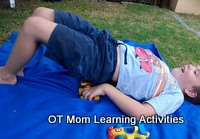 Strengthening his core
Strengthening his coreImagine trying to paint a wall while dangling from a rope or working on a wobbly stepladder. The paint will go everywhere and it will be really hard to get the paint to land on the right spot.
Just as you need your stepladder to be your stable base in order to paint effectively, your body needs core strength to provide core stability in order to carry out your daily tasks with minimum effort and no strain on your body.
The Core Muscles
The core muscles can be divided into two groups:
- Deep core muscles (also called the local core muscles): these primarily work to stabilise the spine. Specific exercises that incorporate slow movements with low resistance can strengthen these muscles.
- Superficial core muscles (called the global core muscles): these work to move the spine – bending, straightening, twisting etc, as well as being involved in moving the limbs. These muscles tend to be activated with rapid movements and higher resistance.
There is not one specific muscle group that is primarily responsible for core stability – all the muscles of the core work together. That is why we aim to strengthen the entire core, using a range of different core exercises.
Why Is Core Stability Important for Kids?
- Good core strength and stability will help your child to maintain a good sitting posture at the desk, and will help develop a stable, supportive base for gross motor and fine motor movements.
- A good sitting posture can help your child with handwriting.
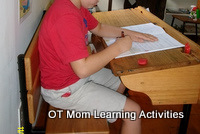
- A good sitting posture also may also help your child's visual perception, as the head (and therefore the eyes) are in a better position for copying from the blackboard, following a line of text when reading, and laying work out properly on the page.
- In the long run, strengthening your child's core muscles may help your child to avoid the lower back pain with which so many adults are plagued.
- If your child is already a keen athlete, strengthening the trunk muscles may enable your child to use the arms and legs more strongly, in a more coordinated way.
- Good core strength may also have a positive impact on your child’s balance and improve the ability to sit well at a desk instead of slouching all over it!
- Your child’s endurance of gross and fine motor tasks may also be better if the core muscles are strong.
Does My Child Have Weak Core Muscles?
These are some signs that your child may be struggling with weak core muscles:
- Instead of sitting upright, does your child tend to lie all over the desk, supporting the body weight on the arms and propping the head in a hand?
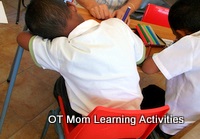 Does your child lie on the desk while working?
Does your child lie on the desk while working?- Does your child hook his/her arms over the back of the chair, rock on the chair and generally drive you crazy with an inability to sit still in a chair?
- Does your child prefer to lie down to watch TV instead of sitting upright, or prefer to lie down during mat work at school?
- Does your child slouch against the nearest wall or table, instead of standing up straight?
- Does your child struggle to balance while lifting one leg off the ground, or lose his/her balance easily during gross motor activities and sports?
- Does your child have poor gross motor skills and general clumsiness?
- Does your child avoid climbing on playground equipment and/or trees?
An assessment by a pediatric physical therapist or occupational therapist can help to identify and treat the underlying cause of the poor core stability, which may be low muscle tone, developmental delay, sensory processing disorder or a genetic disorder among other things.
This page is not intended to diagnose or treat any disorder!
Improving Your Child's Core Strength
Most children nowadays need some encouragement to get away from their
screens and get active.
- Going to the park, playing outdoors, and
engaging in gross motor games and sports are great ways to improve your
child's endurance, strength and core stability.
- Encourage your child to climb on playground equipment, and play physically active games with you.
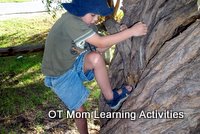 Climbing trees can build core strength
Climbing trees can build core strength- To help your child develop core stability, it is best to choose activities that will require a low level of exertion for a slightly longer period of time, rather than doing lots of high resistance exercises at a faster pace.
- Activities which emphasize control and endurance are better for core stability than those that emphasize force/strength and speed.
-
I have put together a few helpful tips and photographed core strength activities on my
website that you can easily do at home.
This free page includes a great tip on how to help your child to "activate" the core muscles properly!
- Want lots of accessible, printable core exercises?
My Core Exercises for Kids download contains more than 45 pages, with 20+ pages of photographed exercises and activity ideas, as well as helpful information and an exercise planner.
View my Core Exercises download now!
Thank you for visiting my site! I hope you found this page helpful!
Why not sign up for my free, occasional newsletter to stay in touch with new ideas and updated pages on my site?
- Home Page
- Gross Motor Activities
- Core Strength and Core Stability
Share this page to help others!
Related Pages
References
All links open in new tab/window.
Faries, M.D. and Greenwood, M. (2007). Core training: Stabilizing the confusion. Strength and conditioning journal. 29. 10-25. https://doi.org/10.1519/00126548-200704000-00001
K Au, M.; M Chan, W.; Lee, L.; MK Chen, T.; MW Chau, R.; and Pang, M. Core Stability Exercise Is As Effective As Task-Oriented Motor Training In Improving Motor Proficiency In Children With Developmental Coordination Disorder: A Randomized Controlled Pilot Study. Clinical Rehabilitation. 28(10) March 2014. https://doi.org/10.1177/0269215514527596 (abstract only)
Mcgill, S. (1999). Stability: From biomechanical concept to chiropractic practice. J Can Chiropr Assoc. 43.
Oliver, G.; Stone, A. and Plummer, H. (2010). Electromyographic Examination of Selected Muscle Activation During Isometric Core Exercises. Clin J Sport Med. 2010 Nov; 20(6):452-7. doi: 10.1097/JSM.0b013e3181f7b0ef. https://www.ncbi.nlm.nih.gov/pubmed/21079441
Vera-Garcia, F.; Elvira, J.; Brown, S. and Mcgill, S. (2007). Effects of abdominal stabilization maneuvers on the control of spine motion and stability against sudden trunk perturbations. Journal of electromyography and kinesiology : official journal of the International Society of Electrophysiological Kinesiology. 17. 556-67. https://doi.org/10.1016/j.jelekin.2006.07.004
Willson, J.; Dougherty, C.; Ireland, M. and Davis, I (2005). Core Stability and Its Relationship to Lower Extremity Function and Injury. The Journal of the American Academy of Orthopaedic Surgeons. 13. 316-25. https://doi.org/10.5435/00124635-200509000-00005
Didn't find what you were looking for? Try a search of my site!
